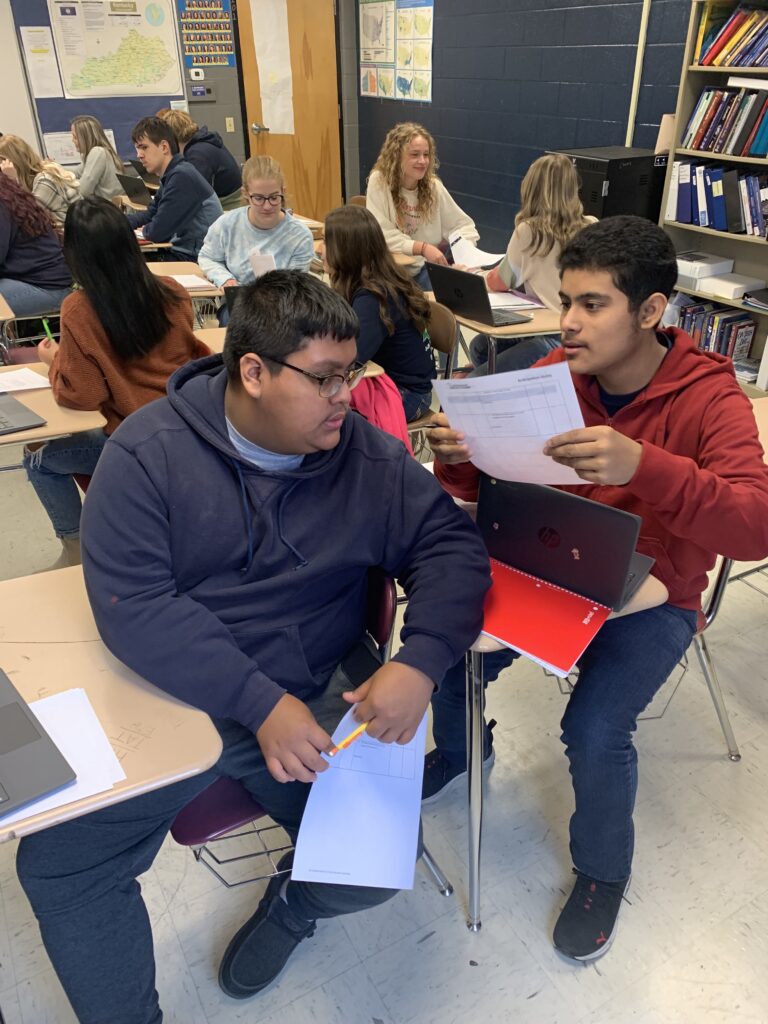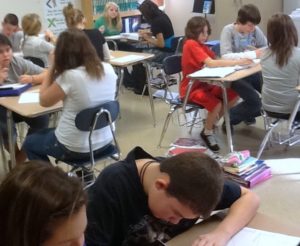As we work to prepare our students for rigorous mathematics standards, I am continually reminded that the focus needs to move away from the teacher and shine on the student. Academic Dialogue is one way of focusing on the student. It allows students to talk about what they know, ask questions about what they don’t know, and lets them build their understanding.
NCTM and new state standards develop the need for students of mathematics to develop their communication skills very intentionally. In 1989, NCTM described having students:
- organize and consolidate their mathematical thinking through communication
- communicate their thinking coherently and clearly to peers, teachers, and others
- use the language of mathematics to express mathematical ideas precisely.
The Mathematical Practice standards also provide ample opportunity for students to communicate around mathematical topics as well, including:
- (students can) understand the approach of others to solving complex problems and identify correspondences between different approaches.
- make conjectures and build a logical progression of statements to explore the truth of their conjectures
- justify (students’) conclusions, communicate them to others, and respond to the arguments of others
- students at all grades can listen to the arguments of others, decide whether they make sense, and ask useful questions to clarify or improve the arguments
Brain research also indicates that the brain looks for and creates patterns to make meaning (Sousa, 2022; Caine & Caine, 1994) and integrates new information into existing structures and patterns. The brain is also designed for complex tasks that are complex, rich, and multi-sensory (Jenson, 2000) rather than linear, lock-step kinds of instruction (Schenck, & Cruickshank, 2015; Roberts, 2002).
In CTL’s Adolescent Literacy Model’s Mathematics Guidebook (2018), we push for students to have reading, writing, speaking/listening in every class, every day. It might seem intimidating at first. It just takes a commitment to good mathematics instructional practices that provide students opportunities to create conceptual knowledge and understanding to accompany procedural knowledge.
Building Academic Dialogue Capacity in your Students
Incorporating academic dialogue into a mathematics classroom is easy if you start small and build your understanding of the processes as you go. The Conditions for Thinking and Learning provide a framework for expectations. It provides structure for building community and the expectations for contributing knowledge. These structures include asking questions, providing evidence, and share ideas. Using the framework provides tangible things students can do to contribute and it gives the teacher opportunity to help students focus their efforts. The results show up in a simple Think, Ink, Pair, Share when students talk to each other about a particular problem, they are aware how to listen to their peer and ask probing questions or make connections to work they have done previously. Here is a link to a short video that shows a teacher using small groups around specific problem solving tasks to have students talking to each other about the why and how of solving problems.
understanding of the processes as you go. The Conditions for Thinking and Learning provide a framework for expectations. It provides structure for building community and the expectations for contributing knowledge. These structures include asking questions, providing evidence, and share ideas. Using the framework provides tangible things students can do to contribute and it gives the teacher opportunity to help students focus their efforts. The results show up in a simple Think, Ink, Pair, Share when students talk to each other about a particular problem, they are aware how to listen to their peer and ask probing questions or make connections to work they have done previously. Here is a link to a short video that shows a teacher using small groups around specific problem solving tasks to have students talking to each other about the why and how of solving problems.
Instead of telling students how to solve the problems, she allows the students to create their understanding together as she walks around asking clarifying questions and listens for opportunities to push student thinking. This is a win/win situation because the teacher can be sure of what students know when they are producing the product without her input, and students can answer questions about how they got their answer and why their initial answers were wrong.
One of the keys of this video is that the teacher didn’t make the answer to the problem the focus of the conversations. She made the process the focus which allowed the conversations to be flexible and dynamic. The problems she asked students to solve could be solved using different steps and she allowed students to solve the problems as they saw fit rather than creating a lock-step set of rules that are most efficient for students to follow (without necessarily understanding).
To manage the student to student conversations, the teacher used good questions, proximity, asked questions to prompt more discussion, and perhaps most importantly, she provided a simple structure:
- gave the students a task
- provided time for students to think before sharing
- provided specific timeframes for student discussion that was short but not too short
- asked students to share a final product for accountability, and
- has built the expectations of the conditions for thinking and learning over time.
I hope you will incorporate more student to student academic dialogue into your classroom instruction, so students can create knowledge and have a little fun while they do it.
References
Caine, G., and Caine, R. (1994). Making connections: Teaching and the human brain. New York: Addison Wesley.
Jensen, E. (2000). Brain-based learning. San Diego: The Brain Store
Roberts, J. W. (2002). Beyond learning by doing: The brain compatible approach. Accessed March 3, 2023, http://www.icn.ucl.ac.uk/sblakemore/SJ_papers/BlaFri_DevSci05.pdf.
Schenck, J., & Cruickshank, J. (2015). Evolving Kolb: Experiential education in the age of neuroscience. Journal of Experiential Education, 38(1), 73-95.
Sousa, D. (2022). How the Brain Works. California: Corwin Press.

